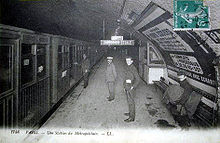Pasteur (Métro Paris)
|
|
|
|---|---|

|
|
| Tariff zone | 1 |
| Line (s) |
|
| place | Paris XV |
| opening | April 24, 1906 |
Pasteur is an underground transfer station of the Paris Métro . It is served by lines 6 and 12 .
location
The metro station is located in the Necker district in the 15th arrondissement of Paris . The station of line 6 is located lengthways under the median of Boulevard Pasteur, south of the Rue de Vaugirard which crosses it . Line 12 station is located lengthways under Rue de Vaugirard to the west of this intersection.
Surname
The name gives the Boulevard Pasteur. The chemist and microbiologist Louis Pasteur (1822–1895) made significant contributions to the prevention of infectious diseases through vaccination . The process of preserving liquids by pasteurization goes back to him.
History and description
The 75 m long station on line 6 went into operation on April 24, 1906, when the Compagnie du chemin de fer métropolitain de Paris (CMP) opened the extension of the then Sud line from Passy to Place d'Italie . On October 14, 1907, the previously independent line 2 Sud became the south-western end section of line 5 ( Étoile - Place d'Italie - Gare du Nord ). The routes were changed again on October 6, 1942, so that line 6 has been running at the station since then. In the early 1970s, the line was converted to run on rubber-tired trains .
Under an elliptical , white-tiled vault, there are two side platforms on two parallel tracks. The side walls of the station follow the curvature of the ellipse. Immediately to the north, the route of line 6 crosses that of line 12 at a right angle. Shortly afterwards it leaves the tunnel and leads as an elevated railway over a ramp onto a viaduct that extends to Passy .
The station of today's line 12 was opened on November 5, 1910. The line went into operation as the first section from Notre-Dame-de-Lorette to Porte de Versailles on Line A of the competing Nord-Sud railway company. On March 27, 1931, line A was renamed line 12 after the Nord-Sud had been absorbed by the previously competing Compagnie du chemin de fer métropolitain de Paris (CMP) the previous year .
Its structure corresponds to the station on line 6, but was optically more elaborate in the north-south style and is higher. An overhead line was installed until the 1930s , as the leading railcar on the Nord-Sud was powered by a pantograph . As is usual with the Nord-Sud, the side walls run straight and vertical in the lower area.
The two entrances are on both sides of the Rue de Vaugirard in the median of the Boulevard Pasteur. The southern one again bears the Art Nouveau décor designed by Hector Guimard , after its curved lanterns had been replaced by a Dervaux candelabra for decades . The northern one shows the typical style of the north-south entrances designed by Adolphe Dervaux , but the original lettering NORD-SUD has been replaced by the word METROPOLITAIN.
vehicles
At first, trains made up of two-axle vehicles with wooden superstructures ran on Line 2 Sud. From around 1910 trains of the Sprague-Thomson type ran on the route . In July 1974 it was converted to vehicles with rubber tires, and the MP 73 series has been running on Line 6 since then .
On line 12, trains of the north-south type Sprague-Thomson ran initially, which differed in several points from the Sprague-Thomson vehicles of the CMP. A striking feature was the power supply of the leading railcar by means of a pantograph. After the takeover of Nord-Sud by CMP, this type of business was given up in the 1930s. In the 1970s, the north-south trains were eliminated in favor of the Sprague-Thomson standard design, and in 1977 modern trains of the MF 67 series came onto the line.
Surroundings
The Pasteur Institute is in the immediate vicinity .
Web links
literature
- Gérard Roland: Stations de métro. D'Abbesses à Wagram . 2003, ISBN 2-86253-307-6 .
Individual evidence
- ^ Gérard Roland: Stations de métro d'Abbesses à Wagram . Christine Bonneton, Clermont-Ferrand 2011, ISBN 978-2-86253-382-7 , pp. 158 .
- ^ Brian Hardy: Paris Metro Handbook . 3. Edition. Capital Transport Publishing, Harrow Weald 1999, ISBN 1-85414-212-7 , pp. 36 .
- ^ Jean Tricoire: Un siècle de métro en 14 lignes. De Bienvenüe à Météor . 2nd Edition. La Vie du Rail, Paris 2000, ISBN 2-902808-87-9 , p. 210 .
- ^ Jean Tricoire: Un siècle de métro en 14 lignes. De Bienvenüe à Météor . 2nd Edition. La Vie du Rail, Paris 2000, ISBN 2-902808-87-9 , p. 294 .
- ↑ a b Jean Tricoire: op. Cit. P. 295.
- ↑ Jean Tricoire: op. Cit. P. 72.
- ^ Julian Pepinster: Le métro de Paris . Éditions La Vie du Rail, Paris 2010, ISBN 978-2-918758-12-9 , p. 106 .
- ↑ Julian Pepinster: op. Cit. P. 91.
- ^ Jean-Pierre Rigouard: Le Métro de Paris. Tome II . 1st edition. Editions Alan Sutton, Saint-Cyr-sur-Loire 2003, ISBN 2-84253-847-1 , p. 68 .
| Previous station | Paris metro | Next station |
|---|---|---|
|
Sèvres - Lecourbe ← Charles de Gaulle - Étoile |
|
Montparnasse - Bienvenüe Nation → |
|
Falguière ← Front Populaire |
|
Volontaires Mairie d'Issy → |
Coordinates: 48 ° 50 ′ 34 " N , 2 ° 18 ′ 46" E



